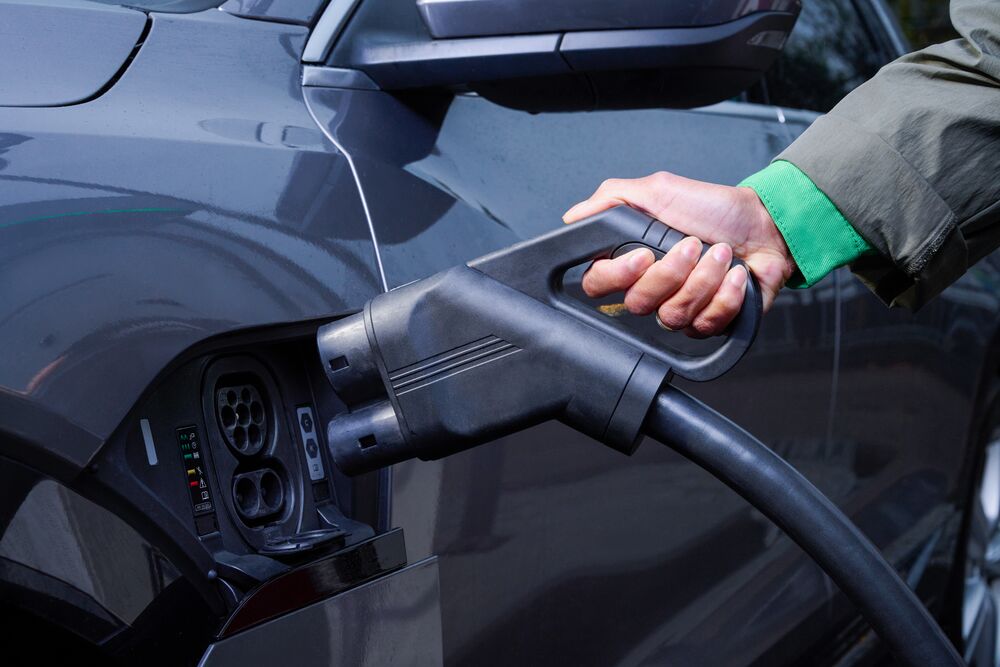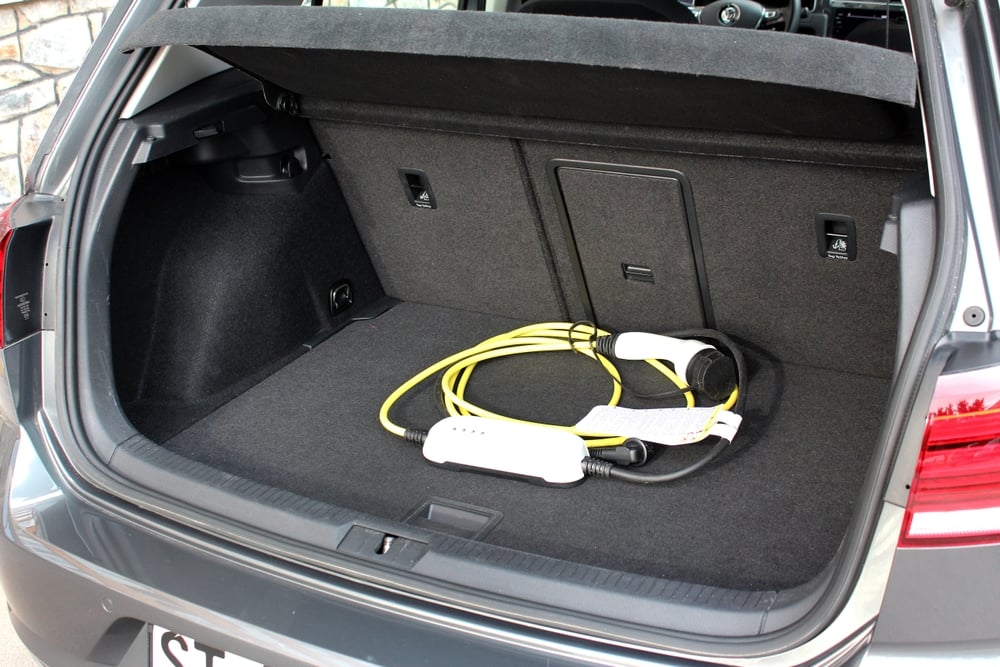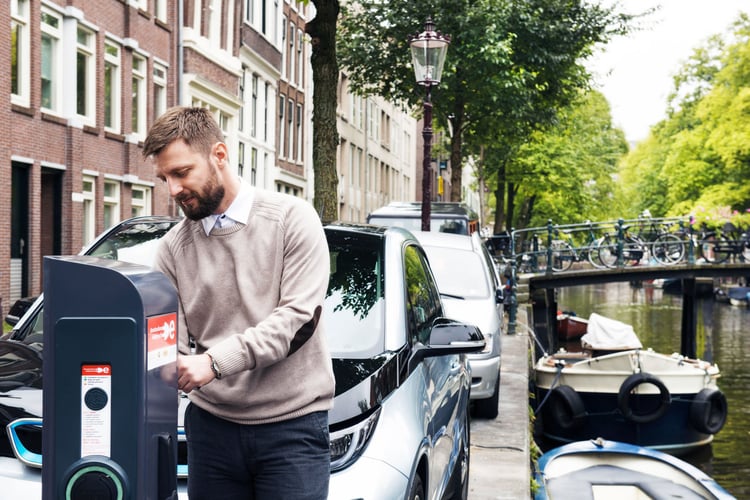
Last updated on December 8th, 2023
Charging an electric vehicle (EV) is not a one-size-fits-all endeavor. Depending on your vehicle, the type of charging station, and your location, you’ll be faced with a different cable, plug... or both.
This article explains the different type of cables, plugs, and highlights country-specific standards and developments.
There are 4 main types of EV charging cables. Most dedicated home EV charging stations and plug chargers use a Mode 3 charging cable and rapid charging stations use Mode 4.
EV charging plugs vary based on the manufacturer and country you find yourself in, but there are a few dominant standards across the world, each used in a particular region. North America uses the Type 1 plug for AC charging and CCS1 for DC rapid charging, while Europe uses the Type 2 connector for AC charging and CCS2 for DC rapid charging.
Tesla cars have always been a bit of an exception. While they’ve adapted their design to fit the standards of other continents, in the US, they use their own proprietary plug, which the company now calls the “North American Charging Standard (NACS)”. Recently, they shared the design with the world and invited other car and charging equipment manufacturers to include this connector type into their designs.
Table of contents
Untangling EV charging cables and plugs
The greatest difference a driver will experience between a vehicle with an internal combustion engine (ICE) and an electric vehicle (EV) is how they refuel. While filling up a conventional vehicle with petrol or diesel is relatively straightforward, switching to electric mobility means trading the familiar petrol pump for an EV charging plug. The world of electric car charging can be daunting and confusing at first, with many different types of cables, plugs, and charging ports used around the world.
With so many variables and new concepts, making sure you’re using the right cable or plug for your charging needs can seem daunting—but it doesn’t have to be. Read on as we untangle the differences between EV charging cables and plugs so you can charge with confidence wherever you go.

EV charging cables
What is an EV charging cable?
EV charger cables are designed to safely deliver power from a power source to your electric car. Some charging stations come with cables attached (these are called tethered charging stations) and others require you to bring your own. Safe to say, charging cables are an essential part of charging an electric vehicle.
Are all EV charging cables the same?
Not at all, EV charging cables come in four forms or “modes”, each used for a certain type of charging. It may get slightly confusing, seeing that the mode does not necessarily correlate to the “level” of charging. In this section, we aim to unpack the difference between Mode 1, Mode 2, Mode 3, and Mode 4 charging cables and determine which is best suited for what type of charging.
EV charging cable types
Mode 1 charging cables
With a Mode 1 cable, you simply connect a light electric vehicle (e-bikes, scooters, but not a car) to a standard AC socket-outlet using an extension cord and standard plug. As a result, there is no communication between the vehicle and the charging point, meaning there are no special safety systems or shock protection. This type of charging is useful for light electric vehicles like e-bikes and scooters, but it’s not considered safe for electric cars and is prohibited in many parts of the world.

Mode 2 charging cables
When you purchase an EV, it usually comes with what’s known as a Mode 2 charging cable. These cables plug into your EV on one end and enable the connection to an ordinary 3-pin domestic socket. Some Mode 2 charging cable are more advanced and offer connectors suitable for different CEE industrial sockets. Mode 2 charging cables come with an In-Cable Control and Protection Device (IC-CPD) which is responsible for the control of the charging process and communication between the electrical power source and the EV.

You can use this cable to plug it into a 3-pin domestic socket and charge without a charging station. While this charging method is undoubtedly convenient, charging using this method can take a long time as most household outlets only deliver up to 2.3 kW of power. It can also be dangerous if handled incorrectly, as it can easily overload your home’s electrical circuit. Therefore, we only recommend using this charging cable if no other options are available. Find out more about how to charge your electric car safely.
Mode 3 charging cables
Mode 3 cables are currently the most common way to charge an EV across the globe. A Mode 3 charging cable connects your vehicle to a dedicated EV charging station—like those found in workplaces and offices, homes and residential locations, and commercial and public parking lots. These cables are the standard across the world for public and home EV charging using a dedicated charging station, and usually connect to Type 1 or Type 2 charging plugs.

Mode 4 charging cables
Mode 4 charging cables are designed to handle higher power outputs needed for rapid charging. Also known as Level 3 charging or DC charging, rapid charging can significantly reduce charging times, allowing you to charge an EV in minutes instead of hours. However, as this type of charging transfers much more power directly to the battery, the cables must be permanently connected to the charging station, are a bit heavier, and sometimes even are liquid-cooled, and to handle the excess heat generated by the higher power output.

Where Mode 1, Mode 2, and Mode 3 charging cables can safely deliver alternating current (AC) to the vehicle, Mode 4 charging cables, are designed to transfer direct current (DC) straight to your battery which enables much rapider charging times. If you want to learn more about the difference between AC and DC charging, read our dedicated article on that topic here.
EV charging plugs
What is an EV charging plug?
An EV charging plug is the connector that you insert into the charging socket of an electric vehicle, which is connected to the charging cable.

Are all EV charging plugs the same?
No, just like how the plugs of electrical appliances differ depending on the country you're in, EV charging plugs and sockets also vary depending on the vehicle model, type of charging level you use, and country the plugs are manufactured in. Luckily, each region has a specific standard, so you shouldn’t encounter an unfamiliar plug too often.
EV charging plug types
Here’s an overview of types of charging plugs for both AC charging and DC charging with a picture of each (so you know what they’ll look like) and the locations you are likely to find them.
AC charging plugs
These plugs are used when charging at an AC charging station, this could be a public charging station you find in cities, a workplace charger at the office, or a home charging station.
| Plug type | Design | Power output* | Locations |
| Type 1 | Up to 7.4 kW | Japan and North America | |
| Type 2 | Up to 22 kW for private charging Up to 43 kW for public charging |
UK, Europe and the rest of the world | |
| GB/T | Up to 27.7 kW | China |
*These numbers represent the maximum power output that a plug can deliver at the time of writing this article. The numbers do not reflect actual power outputs as this is also dependent on the charging station, charging cable and the receptive vehicle.
AC charging plug types explained

Type 1 charging plug
Type 1 plugs—also referred to as SAE J1772—are most commonly used with vehicle models found in Japan and North America. They are single-phase and can deliver a power output of up to 7.4 kW.
Type 2 charging plug
Type 2 plugs—also referred to as “Mennekes” in reference to the German company that originally designed them—are the official plug standard for the European Union and the UK. These three-phase plugs have a higher power transfer capacity than Type 1 plugs, delivering up to 22 kW for private charging and up to 43 kW for public charging. This is because a three-phase power supply can transmit three times as much power as a single-phase power supply,
However many UK homes don't have this from the get-go, nevertheless, it may be possible to upgrade your home's electrical system to accommodate a three-phase connection, but this may come at a significant cost.
GB/T charging plug
China developed its own charging system, referred to by its Guobiao national standards as GB/T. There are two variations of GB/T plugs: one for AC charging and one for DC rapid charging. The GB/T AC charging plug is single-phase, delivering up to 27.7 kW. While it looks the same as the Type 2 plug, don’t be fooled—its pins and receptors are reversed.
The difference between single-phase and three-phase power
In electricity, a phase refers to the distribution of a load, and single-phase power is a two-wire alternating current (ac) power circuit. There is a more powerful alternative known as three-phase power. The key difference between single-phase vs. three-phase is that a three-phase power supply better accommodates higher loads.
To describe it less technically: A three-phase power supply can transmit three times as much power as a single-phase power supply. Turning the lights on at home? Single-phase power will do. A commercial dishwasher used in restaurants? Three-phase power is usually required.
DC rapid-charging plugs
These plugs are used at rapid-charging stations usually found alongside highways, at fuel retail locations or dedicated rapid-charging hubs.
| Plug Type | Design | Power output* | Locations |
| CCS1 | Up to 350 kW | North America | |
| CCS2 | Up to 350 kW | UK and the rest of Europe | |
| CHAdeMO | Up to 200 kW | Japan | |
| GB/T | Up to 250 kW | China |
DC rapid-charging plugs explained
CCS charging plug
The Combined Charging System, or CCS for short, is the DC rapid-charging plug standard in North America (CCS1) and Europe (CCS2). It’s called a combined charging system because it supports both AC and DC charging and integrates the Type 1 and 2 AC charging plugs discussed above in their design.
CCS1
The CCS1 plug is an enhanced version of the Type 1 AC plug with two additional power contacts to enable DC rapid charging. CCS1 is the most common rapid-charging plug across North America besides Tesla's Supercharger technology which has its own plug. CCS1 supports power outputs of up to 350 kW.
CCS2
The CCS2, on the other hand, is an enhanced version of the Type 2 AC plug with two additional power contacts to enable DC rapid charging. CCS2 plugs can deliver between 50 kW and 350 kW of DC power. AC charging is also supported by plugging a standard Type 2 (for CCS2) plug into the upper half of the plug while leaving the lower DC power contacts empty. CCS2 is mainly used in UK and the rest of Europe, where the Type 2 plug is the dominant AC charging standard.
CHAdeMO
Developed in Japan, the CHAdeMO charging plug enables rapid charging of up to 500 kW as well as bidirectional charging. At the moment, Asia is leading the way in manufacturing EVs compatible with CHAdeMO plugs, and CHAdeMO announced that they've developed rapid charging technology capable of power outputs between 500 kW and 900 kW.
However, these speeds are not yet widely available and will become more common in Asia as time goes on. You may also find CHAdeMo plugs in Europe, however, since 2018, they have slowly been phased out as CCS2 gained in popularity and became the standard across the continent.
GB/T
The current GB/T DC charging plug can deliver up to 500 kW. China’s Electricity Council is also currently developing a new version, in partnership with the CHAdeMO Association, that could deliver up to a whopping 900 kW. This latest version—called ChaoJi—enables DC charging at over 500 kW while ensuring safety thanks to a durable cable and plug design.
ChoaJi
ChaoJi is backward compatible with both GB/T and CHAdeMO plugs, allowing for an easy transition. ChaoJi is also one of the first charging standards to have built-in support for vehicle-to-grid (V2G) and vehicle-to-home (V2H) technology, enabling advanced communication between EVs and the charging infrastructure around them. Backed by China and Japan—a significant collaboration aligning two historically distinct markets—ChaoJi will replace GB/T DC chargers in China (with a version called ChaoJi-1) and CHAdeMO chargers in Japan (ChaoJi-2, also known as CHAdeMO 3.0).
The exception: How to charge a Tesla (and can non-tesla cars use superchargers)?
Tesla charger plug
With over 45,000 Superchargers, Tesla owns and operates the largest rapid-charging network in the world. Until recently, this network was exclusively for the high-speed charging of Tesla vehicles, with its own charging connector design. Not too long ago, this meant that Tesla owners who wanted to charge their EVs at a non-Tesla charging station had to familiarise themselves with different connection adapters and that non-Tesla drivers simply couldn’t charge their car at a Tesla charging station.

Non-Tesla supercharger
Tesla made concessions in Europe and adopted CCS2 for their vehicles in the continent. At the same time, Tesla also offered a CCS to the Tesla proprietary plug adapter, allowing Tesla drivers outside of Europe to charge at non-Tesla charging stations. But things have evolved further. In November 2021, Tesla began opening up their network to non-Tesla cars.
Tesla NACS
Only a year after that, in November 2022, Tesla shared their EV connector design with the world and invited charging network operators and vehicle manufacturers to put the Tesla charging connector and charge port, now called the North American Charging Standard (NACS), on their equipment and vehicles.
Ready to start charging?
With so many charging cables and plug types out there, it can be confusing to know which one is right for your vehicle. We hope this article has helped you get your head around the most common types so you can start charging with ease.

When it comes to EV adoption and especially the experience of charging a vehicle, many things are new and different from what we’re all used to. And this goes far beyond the variety of existing charging cables and plugs. What about the average battery life or the available range of EVs today? Or the array of charging locations, the different types of charging and their cost, or even charging speeds. Take a look at our beginner’s EV charging guide for an overview of everything you need to know about charging an electric car.
Related articles

7 FAQs about electric car charging
Only a few years ago, electric mobility seemed like a futuristic idea or a hypothetical concept. Nowadays, electric...

Electric car charging cables and plugs explained [2023 update]
Last updated on December 8th, 2023 Charging an electric vehicle (EV) is not a one-size-fits-all endeavor. Depending on...

Where to charge an electric car?
Today, nearly half of all prospective new car buyers are thinking of going electric. Lower prices, wider model variety,...
